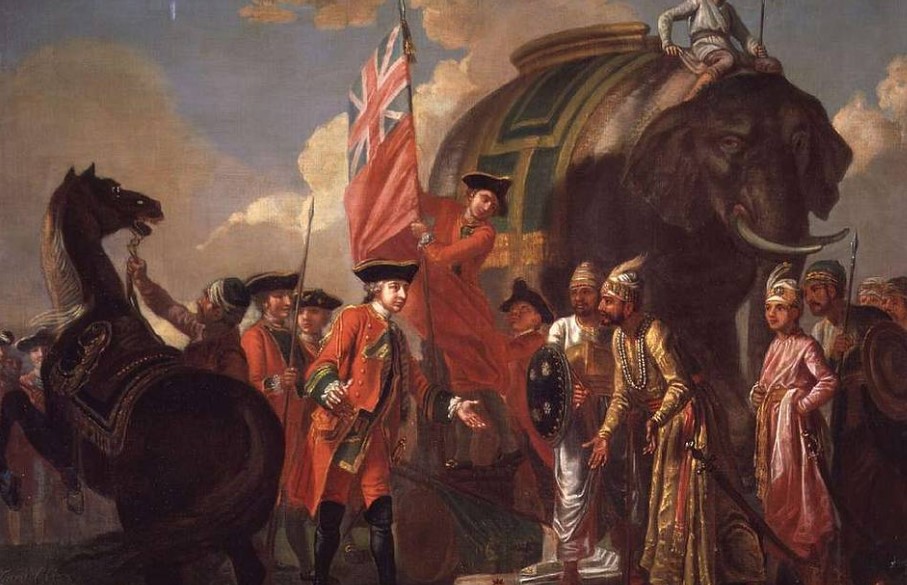
Modern History MCQs – 12 (Khilafat and Non Cooperation Movement)
Most important multiple choice questions from the chapter – Khilafat and Non Cooperation Movement MCQs.
Home » UPSC Study Materials » Prelims Express » Chapterwise MCQs » Modern History MCQs » Modern History MCQs – 2 (Battle of Plassey and Battle of Buxar)
Battle of Plassey and Battle of Buxar multiple choice questions with answers and explanations for all Examinations.
Q 1. Which one of the following was the last Governor of Bengal appointed by the Mughal emperor?
(a) Sartraz Khan
(b) Murshid Quli Khan
(c) Alivardi Khan
(d) Shujauddin Muhammad Khan
Correct Answer: (b) Murshid Quli Khan
Q 2. The Battle of Plassey was fought in the year ?
(a) 1761
(b) 1757
(c) 1760
(d) 1764
Correct Answer: (b) 1757
Q 3. Who is considered as the founder of the British Empire in India?
(a) Warren Hastings
(b) Lord Amherst
(c) Robert Clive
(d) Lord William Bentinck
Correct Answer: (C) Robert Clive
4. Which of the following shifted his capital from Murshidabad to Munger?
(a) Alivardi Khan
(b) Siraj-ud-Daula
(c) Mir Jafer
(d) Mir Qasim
Correct Answer: (d) Mir Qasim
(a) The battle of Buxar
(b) The battle of Plassey
(c) The battle of Wandiwash
(d) The third battle of Panipat
Correct Answer: (a) The Battle of Buxar
6. Who was the ruler of Delhi at the time of the battle of Buxar?
(a) Aurangzeb
(b) Shah Alam I
(c) Bahadur Shah Zafar
(d) Shah Alam II
Correct Answer: (d) Shah Alam II
7. Who was the Nawab of Bengal when the Battle of Buxar was fought?
(a) Sirajuddaula
(b) Mir Jafar
(c) Mir Qasim
(d) Naeem Ud Daula
Correct Answer: (c) Mir Qasim
8. Which one of the following rulers granted Diwani to the East India Company ?
(a) Farukhsiyar
(b) Shah Alam- I
(c) Shah Alam- II
(d) Shujauddaula
Correct Answer: (c) Shah Alam- II
9. In which Governor’s tenure, Diwani rights of Bengal, Bihar and Odisha was granted to the East India Company by Emperor Shah Alam?
(a) Robert Clive
(b) Lord Cornwallis
(c) Lord Wellesley
(d) Lord William Bentick
Correct Answer: (a) Robert Clive
10. Which one of the following is the correct chronological order of the battles fought in India in the 18th Century?
(a) Battle of Wandiwash-Battle of Buxar-Battle of Ambur-Battle of Plassey
(b) Battle of Ambur-Battle of Plassey-Battle of Wandiwash-Battle of Buxar
(c) Battle of Wandiwash-Battle of Plassey-Battle ofAmbur-Battle of Buxar
(d) Battle of Ambur-Battle of Buxar-Battle of Wandiwash-Battle of Plassey
Correct Answer: (b) Battle of Ambur-Battle of Plassey-Battle of Wandiwash-Battle of Buxar
More questions are coming soon. Join us on Whatsapp for latest updates: Join CivilsCracker on Whatsapp

Most important multiple choice questions from the chapter – Khilafat and Non Cooperation Movement MCQs.

Most important multiple choice questions from the chapter – Simon Commission and Nehru Report MCQs.

Most important multiple choice questions from the chapter – Civil Disobedience Movement MCQs.

Most important multiple choice questions from the chapter – Communal Award and Poona Pact MCQs.

Most important multiple choice questions from the chapter – Individual Satyagraha and Cripps Mission MCQs.

Most important multiple choice questions from the chapter – Quit India Movement MCQs.

Most important multiple choice questions from the chapter – Indian National Army and Royal Indian Navy Mutiny MCQs.

Most important multiple choice questions from the chapter – Cabinet Mission and Formation of Constituent Assembly MCQs.

Most important multiple choice questions from the chapter – Independence and Partition of India MCQs.
We are adding new Notes, Chapterwise MCQs, Quizzes, Previous Years Questions everyday
We are adding new Notes, Chapterwise MCQs, Quizzes, Previous Years Questions everyday